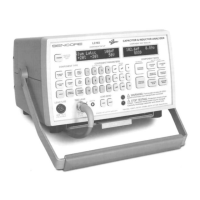58
GLOSSARY
Henry - The unit of the measure of inductance. Also
expressed in microhenry and millihenry.
Inductor - a device consisting of one or more windings
with or without a magnetic material core or that
introduces inductance into a circuit.
Inductance - the property of a coil or transformer which
induces an electromagnetic force in that circuit or a
neighboring circuit upon application of an alternating
current.
Inductive reactance - the opposition of an inductor to
an alternating or pulsating current.
Impedance - the total opposition of a circuit to the flow
of an alternating or pulsating current.
Insulation resistance - the ratio of the DC working
voltage and the resulting leakage current through the
dielectric. Generally a minimum value is specified,
usually in the several thousand megohms range.
Iron core - the central portion of a coil or transformer.
Can be a powdered iron core as in small coils used in RF
to the large iron sheets used in power transformers.
Leakage current - stray direct current flowing through
the dielectric or around it in a capacitor when a voltage
is applied to its terminals.
Metalized capacitor - one in which a thin film of metal
has been vacuum plated on the dielectric. When a
breakdown occurs, the metal film around it immediately
burns away. Sometimes called a self-healing capacitor.
Monolithic ceramic capacitor - a small capacitor made
up of several layers of ceramic dielectric separated by
precious metal electrodes.
Mutual inductance - the common property of two
inductors whereby the induced voltage from one is
induced into the other. The magnitude is dependent upon
the spacing.
NPO - an ultra stable temperature coefficient in a
ceramic disc capacitor. Derived from "negative-positive-
zero". Does not change capacity with temperature
changes.
Padder - a high capacity variable capacitor placed in
series with a fixed capacitor to vary the total capacity of
the circuit by a small amount.
Power factor - the ratio of the effective resistance of a
capacitor to its impedance.
Reactance - the opposition of a capacitor or inductor to
the flow of an AC current or a pulsating DC current.
Self-healing - term used with metalized foil capacitors.
Solid tantalum capacitor - an electrolytic capacitor
with a solid tantalum electrolyte instead of a liquid. Also
called a solid electrolyte tantalum capacitor.
Surge voltage - the maximum safe voltage in peaks to
which a capacitor can be subjected to and remain within
the operating specifications. This is not the working
voltage of the capacitor.
Temperature coefficient (TC) - the changes in capacity
per degree change in temperature. It can be positive,
negative, or zero. Expressed in parts per million per
degree Celsius linear types. For non-linear types, it is
expressed as a percent of room temperature.
Time constant - the number of seconds required for a
capacitor to reach 63.2% of its full charge after a voltage
is applied. The time constant is the capacity in farads
times the resistance in ohms is equal to seconds (T =
RC).
Trimmer - a low value variable capacitor placed in
parallel with a fixed capacitor of higher value so that the
total capacity of the circuit may be adjusted to a given
value.
Variable capacitor - a capacitor that can be changed in
value by varying the distance between the plates or the
useful area of its plates.
Voltage rating - see working voltage.
Wet (slug) tantalum capacitor - an electrolytic
capacitor having a liquid cathode.
Working voltage - the maximum DC voltage that can
be applied to a capacitor for continuous operation at the
maximum rated temperature.

